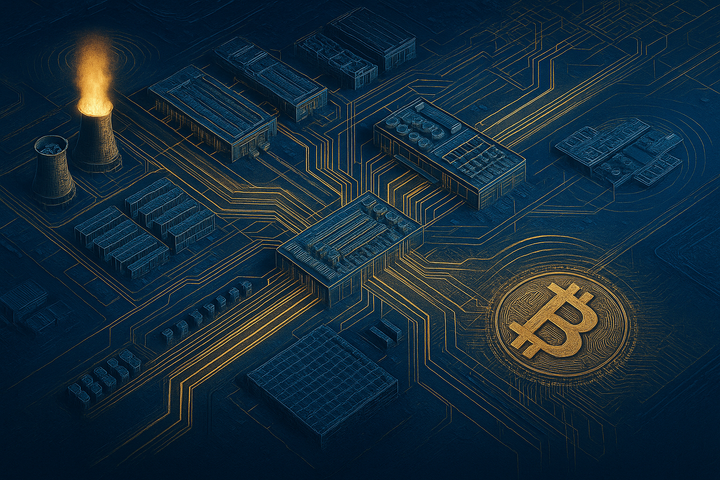Decentralizing Block Templates and Home-Mining Economics
The October 06, 2025 episode of The Bitcoin Layer features Robert Warren explaining residential mining economics and the governance risk of pool-controlled block templates.

- My 'briefing notes' summarize the content of podcast episodes; they do not reflect my own views.
- They contain (1) a summary of podcast content, (2) potential information gaps, and (3) some speculative views on wider Bitcoin implications.
- Pay attention to broadcast dates (I often summarize older episodes)
- Some episodes I summarize may be sponsored: don't trust, verify, if the information you are looking for is to be used for decision-making.
Summary
The October 06, 2025 episode of The Bitcoin Layer features Robert Warren explaining residential mining economics and the governance risk of pool-controlled block templates. Warren details how heat reuse, payout models, and direct-DC solar integration shape feasibility for households and small operators. He argues that miner-constructed templates via Stratum v2 and DATAM, alongside open-source hardware, are central to long-run decentralization and resilience.
Take-Home Messages
- Heat-first economics: Treat miners as controllable heaters; thermal reuse often determines residential viability more than raw hashrate.
- Payout risk transfer: FPPS smooths income but loads treasury and fee risk onto pools, while PPLNS lowers overhead yet raises variance for miners.
- Template decentralization: Pool-controlled block templates concentrate censorship risk; Stratum v2 and DATAM return selection power to miners.
- Supply concentration: Two-vendor ASIC dominance is a structural fragility; open-source boards, firmware, and designs mitigate single points of failure.
- Energy integration: Direct-DC solar and smart-home routing can cut losses and convert mining into an energy-appliance use case.
Overview
Robert Warren explains that home mining works best when households capture waste heat for water and space heating, reframing a miner as a thermal appliance with a revenue kicker. He compares solo mining’s lottery-like odds against the steadier cash flows of pools and links the choice to budget and risk tolerance. By anchoring decisions in heat, tariffs, and comfort constraints, he shifts analysis from abstract hashrate to concrete household engineering.
He traces the rise of pools as a coordination solution to variance, then walks through FPPS and PPLNS to show how cash-flow smoothing relocates risk. FPPS requires large treasuries and exposes pools to fee volatility as the subsidy declines and fee shares fluctuate. PPLNS reduces overhead yet forces miners to tolerate payout variance and longer settlement horizons.
Warren flags that pool-controlled block templates concentrate transaction-selection power, creating a censorship vector at the pool layer. He points to Stratum v2 and DATUM as practical paths to restore miner-side template construction and limit central choke points. He adds that real adoption lags because running a node, managing templates, and retooling operations impose costs and complexity.
On hardware, Warren notes the industry’s reliance on two major ASIC vendors and calls it a systemic fragility for supply and maintenance. He highlights open-source efforts across control boards, firmware, and small-scale designs to broaden participation and resilience. He closes with direct-DC solar concepts and smart-home plumbing that route heat to hydronic loops, HVAC returns, and water tanks to improve total household efficiency.
Stakeholder Perspectives
- Home miners: Seek clear guidance on safe thermal capture, noise control, payout variance, and practical node/template operations.
- Mining pools: Balance user growth with treasury exposure and fee volatility, especially under FPPS commitments as subsidy declines.
- Protocol and client developers: Prioritize Stratum v2/DATAM tooling, usability, and interoperability to lower adoption friction for miner-constructed templates.
- ASIC vendors and open-hardware teams: Compete on efficiency and reliability while reducing single-vendor dependence through open reference designs.
- Energy and HVAC professionals: Evaluate code-compliant direct-DC and hydronic integrations that deliver predictable comfort and electrical safety.
Implications and Future Outlook
If miner-constructed templates scale, censorship risk at the pool layer diminishes and block selection becomes harder to coerce. Without adoption, transaction filtering pressure can concentrate in a few operational hubs with outsized influence. Tooling, managed services, and education will decide which path prevails over the next cycle.
Fee-dominant reward eras will stress cash-flow promises embedded in FPPS and force new disclosures about treasury sufficiency and variance policies. Pools that cannot quantify and price fee risk may consolidate or revert to models with clearer risk placement on miners. Transparent accounting could become a market differentiator and a policy focus.
Open-source hardware and control stacks can expand supplier diversity and reduce downtime risks for small operators and communities. Direct-DC solar and thermal routing may reposition miners as grid-aware appliances that support resilience and local heat needs. These shifts broaden participation and align mining with household and microgrid objectives.
Some Key Information Gaps
- What measurable conditions indicate unacceptable censorship risk from pool-controlled block templates? Establishing clear thresholds guides protocol choices and operational responses.
- Under what fee and subsidy scenarios do FPPS payout promises become capital-inefficient or unsustainable for pools? Scenario analysis clarifies solvency risks and improves disclosure standards.
- What engineering steps and safety constraints are required for reliable direct-DC solar-to-hashboard operation? Clear guidance reduces failures and accelerates safe residential deployments.
- Which open-source hardware milestones would materially diversify supply and reduce single-vendor dependence? Targeted milestones focus resources on resilience-enhancing deliverables.
- Which education and tooling interventions most reduce setup complexity for Stratum v2/DATAM adoption? Practical interventions increase miner-side template construction at scale.
Broader Implications for Bitcoin
Decentralized Transaction Selection
Miner-constructed templates reduce leverage points for policy or private pressure at intermediaries and distribute decision-making to the network edge. Over time, this can make censorship attempts more costly, less predictable, and easier to detect. The result is stronger settlement assurances for users whose transactions could face discretionary filtering.
Market Discipline for Pool Risk
As fees dominate rewards, pools must disclose treasury practices and variance policies with greater precision to retain trust. Clear market signals can reward risk-appropriate models and penalize opaque or undercapitalized commitments. This discipline supports healthier competition and improves system liquidity under volatile fee regimes.
Energy-Appliance Integration
Treating miners as controllable heat sources aligns Bitcoin with household comfort, building heating, and microgrid resilience goals. Appliance-level integrations invite HVAC standards, safety certifications, and service ecosystems that professionalize deployments. The approach broadens participation and opens up opportunities for electricity demand-side demand response participation while reducing noise, waste heat, and electrical hazards.
Supply-Chain Resilience
Open reference designs and modular control stacks reduce vendor lock-in and enable regional repair, refurbishment, and incremental upgrades. Diversified pathways shorten downtime and smooth procurement shocks across jurisdictions and market cycles. This resilience improves uptime economics and dampens systemic stress from concentrated suppliers.
Civic and Policy Literacy
Operational clarity about template control, fees, and energy integration equips policymakers to evaluate real risks and benefits without conflating layers. Better literacy lowers the odds of misguided restrictions aimed at the wrong control points. It also enables proportionate, evidence-based rules that preserve user rights and network reliability.



Comments ()